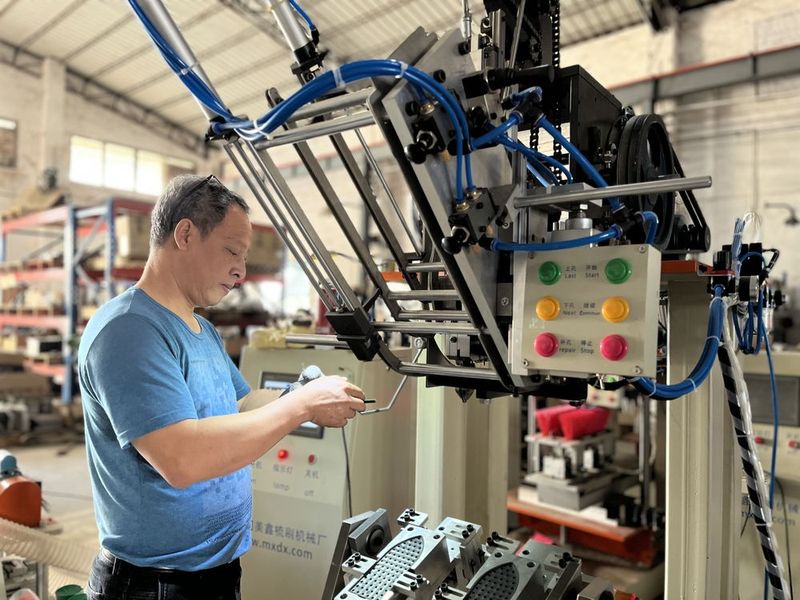Meixin Comb Brush Machinery
A leader in this industry ,specializing in brush making machine line for more than 14 years
1) Introduction:
In the production of brushes, quality control is essential to guaranteeing that the finished product fulfills the necessary requirements for performance, durability, and uniformity. Whether they are industrial, cosmetic, or paintbrushes, creating brushes includes a number of steps where consistency and accuracy are crucial. This business has undergone a revolution because to technological and automated advancements, which enable producers to consistently produce goods. Contemporary brush manufacturing equipment is outfitted with sophisticated quality control mechanisms that employ cameras and sensors to examine every brush. These mechanisms guarantee that only superior items are released onto the market. As they emphasize the technical breakthroughs that guarantee outstanding brush performance, machines help to provide quality control in the brush-making process.
2) Performance and efficiency Brush of Machines:
Machines are essential to preserving quality control in the production of brushes.
In addition to having a fundamental grasp of the production process, quality control plays a crucial role in ensuring that every cosmetic brush fulfills the highest requirements of durability and performance. To ensure constant quality throughout manufacturing, manufacturers use a variety of methods and procedures. From the selection and preparation of raw materials to the last inspection of the completed product, they are involved in nearly every stage of the production process.
Here are some key areas where machines ensure consistency and performance:
i) Material Inspection:
The choice of raw materials determines the quality of the brushes. Materials including handles, ferrules, and bristles are graded and sorted by machines. Raw materials like bristles and ferrules are rigorously inspected to make sure they fulfill the necessary criteria before the production process starts. This involves looking for any flaws, contradictions, or contaminants. For instance, the bristles used to make paintbrushes can be constructed of synthetic, natural, or a combination of the two types of fibers. To make sure the bristles match the necessary requirements, machines are utilized to measure the bristles' diameter, length, and flexibility.
Pet brushes are produced using a number of sophisticated procedures that improve their efficiency and quality beyond the fundamental steps of material preparation, bristle bundling, trimming, handle assembly, and quality checking. These methods take advantage of state-of-the-art technology and creative workflows to satisfy the demanding requirements of the pet care sector.
ii) Quality Inspection and performance test:
Testing and quality control are essential steps in the brush-making process. Every brush is inspected automatically to look for flaws like misaligned handles, uneven trimming, or loose bristles. These devices can identify even the slightest flaws thanks to sophisticated image technologies and sensors.
Additionally, performance testing is done to make sure the brushes work properly. Real-time data from these automated technologies enables producers to quickly detect and resolve problems. Paintbrushes might be put to the test for things like ease of cleaning, bristle retention, and paint-holding ability. It is possible to examine the softness, flexibility, and durability of makeup brushes. In order to assess the effectiveness of the brushes and make sure they live up to client expectations, automated testing equipment replicate real-world use situations.
iii) Automation and advanced technology:
The brush manufacturing sector has changed as a result of automation and advance technologies. Tasks like bristle bundling, cutting, and assembly are performed by automated devices, which decrease the need for manual work and increase uniformity. These technologies can function at a high level of accuracy constantly, accelerating manufacturing and lowering the possibility of human mistake.
For quality control and inspection, cutting-edge technologies like imaging and sensor technology are employed. Defects and essential dimensions can be accurately measured by high-resolution cameras and sensors. Because these technologies offer real-time input, producers are able to recognize and resolve problems right away.

3) Advancement in Material:
The performance and longevity of brushes have been improved by the introduction of novel materials and treatments brought about by developments in materials science and engineering. For instance, synthetic bristles manufactured from cutting-edge polymers can replicate the characteristics of real bristles while providing increased chemical resistance and endurance.
The performance and sustainability of brushes have been improved by the introduction of novel materials, such as biodegradable polymers and synthetic fibers with excellent strength. These materials are prepared and sorted by machines. Handle molding machines form the handles, while bristle cutting machines trim synthetic fibers to the appropriate length. Producing brushes of superior quality requires accuracy and consistency, which these machines guarantee.
Conclusion:
In the production of brushes, quality control is crucial to guaranteeing that the finished product fulfills the necessary requirements for performance and uniformity. Manufacturing has undergone a revolution because to the employment of sophisticated machinery and automation, which has raised production efficiency and precision levels at every stage of the process. Machines are vital to preserving the quality of brushes, from material selection and preparation to bristle setting and quality control. The brush manufacturing business will surely witness further advancements in quality control as technology develops, resulting in even better goods for customers.
Copyright © 2025 Meixin Comb Brush Machinery Co., Ltd. | All Rights Reserved 粤I CP备18042005号-4